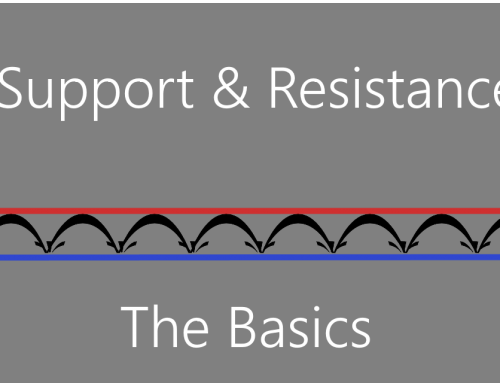This 8-step approach to planning paves the way to profitable stock trading.
When it comes to trading stocks online, it’s not about how hard you work. It’s about knowing the right things to do and putting that knowledge to work. Making money in the stock market isn’t so hard when you apply a simple skill essential to converting the power of knowledge into profits … planning!
Your trading plan is as good as you make it.
“Plan Your Trade and Trade Your Plan” is a mantra you should print out and frame for your wall. Why? Because stock traders who carefully plan have a much better chance of making money than those who don’t. In fact, the simple act of drafting a plan can significantly increase the odds that your trade will be profitable.
A successful trading plan doesn’t have to be complicated. Many traders draft their trading plans in a notebook or on index cards, while others use word processors and spreadsheets. Regardless of the method you choose, every trading plan must include certain components to be effective.
1. Choose Your Style
Before drafting a plan of action, traders will want to decide what style of trading they prefer. A broad generalization of “buy and sell stocks” doesn’t work – the criteria needs to be specific. Successful traders make money in different ways, but each has a well-defined method. On the other hand, a losing trader’s plan is always vague and ambiguous. In trading, it pays to be precise, so decide what you like to do and build your plan around that style.
2. Commit To Your Trading Rules
The best plans always include a set of solid rules that never get broken. These same rules should also address how real-time decisions will be made when managing your stock positions. Your judgment will improve as you gain experience, so it’s good to allow some flexibility in less critical areas of your plan. At the same time, maintain strict rules in the more sensitive parts of your plan – such as Risk Control.
3. Determine Your Time Frame
The type of trading you prefer usually defines the time frame. Short term traders who enjoy a fast paced style won’t find much action in weekly or monthly time frames, while less active traders generally find that the extremely short time horizons require too much time at the computer. Decide which style best suits your personality, and then select the corresponding time frame. It’s usually a good idea to start by spending a few minutes each day. Begin by managing the trades using daily charts, then see if you want to shorten or lengthen the time frame. The RightLine Report offers a variety of stocks in different time frames. Due to the way these stocks are selected and the type of exit strategy used, most of the picks will work for traders who plan to hold positions anywhere from a few hours to a few weeks.
4. Locate The Best Stocks to Trade
Choose a method to determine which stocks to trade. If you are experienced in the markets you probably already have a number of ideas and sources. To make it easier for our subscribers, the Right Line Report presents a wide variety of good stock choices in every issue. They are based on an assortment of trading strategies and tactics that take advantage of predictable market behaviors.
You may also want to develop your own new methods for locating stocks. The RightLine educational section on our website at www.RightLine.net presents numerous market concepts to help traders understand the nature of price movement, identify trends in every time frame, and choose the tools needed to capture profits.
5. Determine Entry Points
This can be a challenge, for there are almost as many different ways to determine entries, as there are stocks. Again, in an effort to make it easier for our subscribers, the Right Line Report presents specific entry points for every stock in each issue. The exact level to buy or sell short is based on a wide range of technical factors used by our analysts to reduce risk and optimize the potential gain. If you choose to select your own entry points, we provide a large assortment of articles to assist you in developing your own personal methods.
6. Use An Intelligent Method to Select the Number of Shares to Trade
Very few traders and investors realize the importance of balanced “Position Sizing.” Most make the mistake of ignoring the size of their trading account when taking on new positions. As a result, many unknowingly join the ranks of high-risk over-traders, and soon find themselves in big trouble. Don’t worry, it’s easy to avoid when you have the RightLine Risk Manager to help! This simple tool is free to subscribers, but if you prefer to do the math yourself, here are the basics:
“Never risk more than 2% of your trading capital in a single trade or more than 6% of your capital at a time. For example, if you have $100,000 in your trading account, the most you should be willing to risk is $2,000. Before buying a stock, review the chart to locate the best place to put a stop loss order. If you determine that the stock requires 5-points to keep you in the trade while it is trending up, the maximum number of shares that you can afford is 400. ($2,000 maximum risk divided by 5-points = 400 shares.)”
You can see that although doing the calculation isn’t terribly hard, the Risk Manager makes the job a whole lot easier!
7. Determine Your Exit Strategy
After you’ve entered a position in a stock and it starts moving, then what? Traders have a lot of different choices when it comes to exiting trades, and the method used can make a world of difference. Some traders routinely use “trailing” stops as their exit strategy of choice, while others choose to exit when the stock hits a certain price, or breaks through a support level, or approaches a resistance level. Other traders will choose to exit based on intra-day swings or expected news releases. When choosing an exit strategy, remember to plan not only for the upside, but the downside too. The exit strategy is one of the most important parts of any trading plan, and it is fundamental for traders to select an exit plan before entering a trade.
8. Manage Risk With Stops
You may already know, but a “stop” is an order to buy at a price above or sell at a price below the current market price. Stops, or stop orders, are used to protect our capital and lock in profits. Placing stops is easy, but locating the best place to put them can be quite challenging. To assist traders with stop placement, every stock entry in the RightLine Report includes a suggested stop level. And of course, we offer plenty of help on our website for anyone who wants to learn more about managing risk with stops.
********************
Trade Planning is one of the most important skills needed for successfully trading the stock market online. Make it your strength and enjoy the results!






